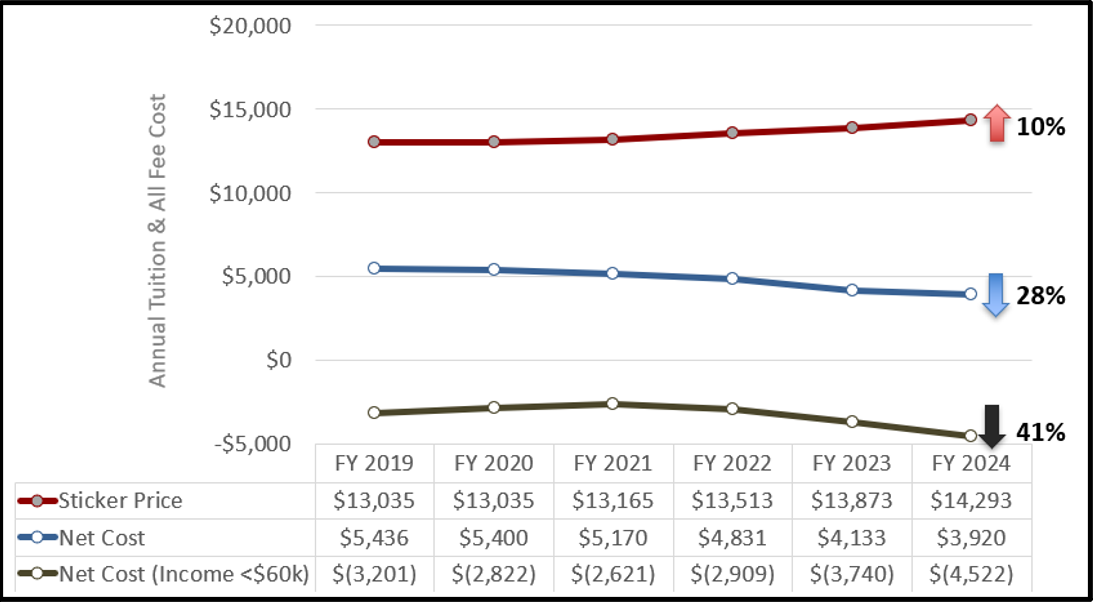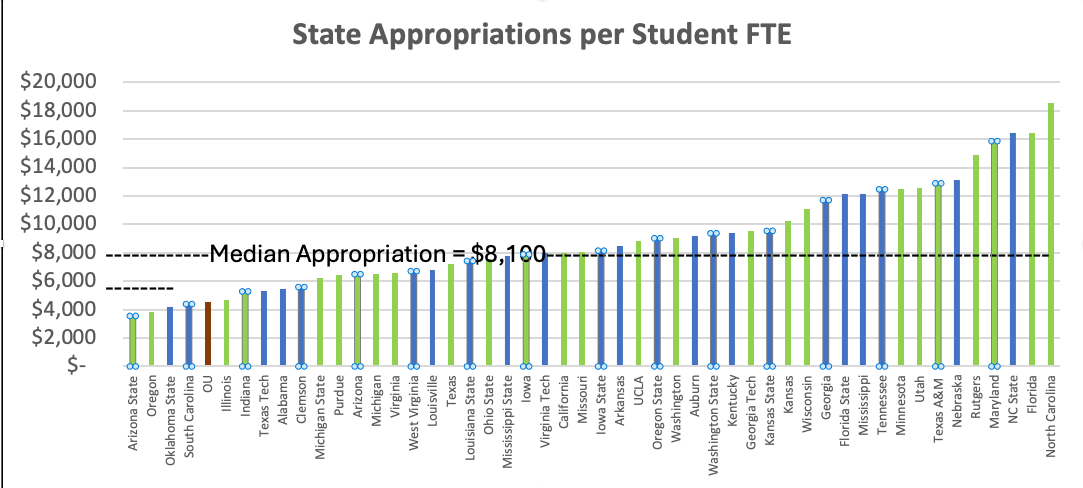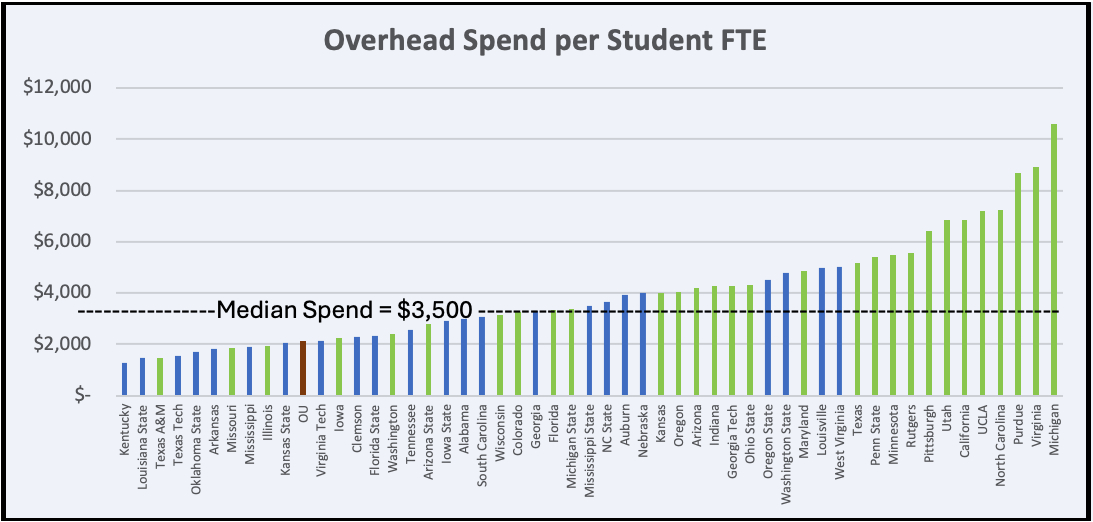Over the past five years, the sticker price of tuition and fees on the Norman campus has risen 1.2% per year for resident undergraduates and 1.8% per year for nonresident undergraduates – both well below the annual inflation rate of 3.1%. However, during this same five-year time frame, OU has significantly increased tuition waivers, scholarships, and grants (WSG) awards – which has substantially lowered the actual costs for students and more than offset the sticker price increases.
Because of these efforts, an OU degree is more affordable now than it was five years ago. Over the last five years, resident freshmen have seen a 28% reduction in their net tuition and fees, saving them $1,516 annually. Nonresident freshmen have benefited from a 4% reduction, saving $627 annually.
The graph to the right shows for residents, the tuition and fee sticker price trend, net cost after WSG, and the net cost after WSG for Crimson Commitment students (residents with income below $60,000).

This coming academic year, OU will raise tuition and mandatory fees as follows.
Norman Campus and Law Programs:
Estimated Average Increase to Students (Norman Campus)
UNDERGRADUATES
| Est. Increase: Full Academic Year | Est. Increase: By Semester | |
|---|---|---|
| Residents | $291.60 | $145.80 |
| Non-Residents | $801.60 | $400.80 |
GRADUATE STUDENTS
| Est. Increase: Full Academic Year | Est. Increase: By Semester | |
|---|---|---|
| Residents | $271.20 | $135.60 |
| Non-Residents | $763.20 | $381.60 |
Health Sciences Programs:
The new rates will be effective for the Fall 2024 semester.
The increase, which will generate approximately $7.2 million, will be entirely used to help fund a merit-based salary increase for eligible faculty and staff for FY 2025, which will cost $15 million campus-wide. Maintaining a competitive compensation for our faculty and staff lies at the core of the excellence we owe to our students.
As a public university, the University of Oklahoma places a strong emphasis on balancing academic excellence with affordability and access.
In setting tuition, we must abide by two foundational principles:
Implementing this tuition and mandatory fee increase will provide a stable funding source to support our strategic priorities and forward momentum for years to come.
Prior to recent increases in 2022, state appropriations were below 1999 levels, before adjusting for inflation. OU’s FY 2025 appropriation is consistent with FY 2007 funding levels. While much improved from pre-2022 levels, this funding lags behind other public peers.
See the chart1 below for a comparison to other public universities. There is an $87 million gap between OU’s per student funding level and the median. Even after adjusting for appropriation increases received in FY 2023 and FY 2024, there would still be a $62 million gap between OU and the median.

1Source: IPEDS (FY 2022, most recent available data)
Important funding has been received by the state for one-time/capital costs since 2022 in the amount of $50 million to fund engineering, aerospace, and weather capital projects that expand research efforts aligned with OU expertise, state workforce goals, and federal funding priorities. Still, it’s important to note that these are one-time allocations (not recurring funds). Furthermore, our appropriations have fallen dramatically over the years. In the mid-80s, our state funding made up about 40% of our operating budget. Today, it only makes up roughly 15%.
Over the last five years, we’ve upheld our promise to offer a world-class education at a great value, while also funding strategic priorities that directly correlate to the overarching goals of our Strategic Plan. Examples on the Norman campus include:
Key Research Investments:
Competitive Compensation:
Strategic Faculty Hiring:
Staffing Investments to Serve Students:
Graduate Student Recruitment:
Improvements to the Campus Experience:
OU realizes that tuition increases have a real impact on students and families. OU’s No. 1 fundraising priority is to substantially increase the availability of need-based aid so that students who have the ability to succeed and excel also have the opportunity.
We always want to guarantee that our operations are efficient and that we are not wasteful in our spending. Since FY 2018, OU has identified and saved approximately $140 million annually from our Norman campus operating budget.
One measure to help monitor how well a university allocates its resources to academic, research, and student priorities is to examine its overhead costs (i.e., costs that do not directly support students and faculty, but are still critical to a functioning university (e.g., HR, IT, Finance, Legal, etc.))
OU’s spend on overhead costs is low in comparison to other public universities within major athletic conferences. The graph2 below compares OU, on a per student basis, to all other public universities in major athletic conferences. Of the universities presented, OU has the 11th lowest overhead cost per student. At the median, OU would spend $33 million more than it currently spends to support institutional/overhead activities. Universities that are members of the Association of American Universities (AAU) have their bars shaded green.

2Source: FY 2022 audited financial statements and the Department of Education IPEDS database
For the most recent reporting period, 56% of OU undergraduates graduated with no debt3 (consistent with prior years), compared to 45% at four-year public universities nationwide. Those that did graduate with debt reported $31,694 in debt. These figures and other outcome metrics compare well with public SEC and Big 12 institutions. Using the U.S. Department of Education’s College Scorecard data and IPEDS database shows:
| Student Outcome Metric | OU | SEC Median | Big 12 Median |
|---|---|---|---|
| Median Debt After Graduation4 | $20,650 | $20,500 | $20,500 |
| Students Receiving Federal Loans3 | 33% | 33% | 38% |
| Median Earnings (10-year) | $59,648 | $59,454 | $58,993 |
| Graduation Rate (AY2022) | 76% | 74% | 67% |
3Common Data Set: https://www.ou.edu/irr/other-reports
4Data from the College Scorecard only examines federal loan data and excludes Parent Plus loans. As such debt and loan data will not reconcile to the official debt and loan data the University publicly reports and is listed above the OU/SEC/Big12 table.
Using the most recent data published, OU’s student outcome data is the best of any higher ed institution in the state of Oklahoma, public or private:
Tuition and mandatory fees will increase by 3% for graduate students. However, for several years, OU has been making progress toward increasing support for graduate education. In 2018, OU launched a multi-year initiative to lower fees for graduate assistants (GAs) on the Norman campus, saving these students $3,480 per year compared to six years ago. OU also is implementing an average 63% increase to graduate assistant stipend minimums, effective July 1, 2024.
We understand this decision has real impacts; that’s why a core team of OU administrators engaged student leaders in extensive conversation, holding Fall and Spring meetings to better understand the effects of a tuition and fee increase on students.
Our professionals in the Student Financial Center stand ready to help you as they seek financial aid and create a plan to fund the upcoming year.
As always, we endeavor to be conscientious stewards of our resources and our sacred purpose of changing lives. For any questions or concerns regarding funding a tuition increase, please contact the Student Financial Center.